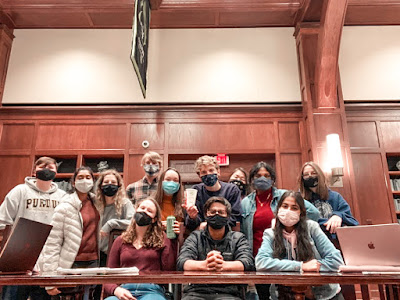Life as a Facilities Engineering Intern
Posted March 11, 2014 by Kat Frangos
I spent this past summer in Covington, Lousiana working as a Facilities Engineering Intern with Chevron. The "facilities" in this case, are the off-shore platforms in the Gulf of Mexico (GOM) and the pipelines that connect them back to shore. This internship was a fantastic adventure for so many reasons and I've accepted a full-time Facilities Engineering position in Covington after I graduate from Purdue.
While I spent the majority of my internship at the Chevron office in Covington (just 45 minutes north of New Orleans), I made 5-6 trips to the offshore platforms as my projects required - several day trips and then a few overnights too. Offshore assets in GOM are divided up into two categories, "shelf" (resources are located < 1000 ft deep) and "deepwater" (> 1000 ft deep). My project this summer were for several "shelf" platforms which were between 5 - 10 minutes offshore by helicopter or an hour boat ride.
When telling people about my internship this past summer, I joke and call myself a pirate. In order to get to an offshore platform, the day begins at roughly 3 in the morning. It's roughly a two-hour drive from Covington out to one of Chevron's shore bases in Venice which is part of Louisiana marshland. At the shore base, you can catch either an early morning helicopter or a crew boat out to the platforms. Helicopter rides start around 6:30 a.m. while the crew boat heads out by first light, usually close to 5:45.
Driving route from Covington, LA out to Venice, LA
Once you've arrived at your platform, there are a couple ways to actually board. The helicopters drop you off on the helipads located on top of the platforms. On the other hand, if you've arrived by boat, you have two options: swing rope (kinda like Tarzan) or a crane personnel basket (see below).
Imagine being hoisted onto a platform while standing in that thing
It's a whole new world out in GOM. Most of the shelf platforms that I visited sit about 30 miles from the shore. The living quarters for each field (which may have include over 20 separate platforms) are located on a central structure that does not have any active production on-board. Meals are served buffet style (the cooks do take orders though, and you'll find the occasional steak). The sleeping quarters are rather comfy bunk beds with separate quarters for the females on-board. Days start around 5 am, breakfast is served between 5 and 6. After breakfast, the Operations Supervisor and the other leaders hold a morning meeting and afterwards, the crews head out to their respective platforms for the day.
All the hustle and bustle of offshore life is pretty exciting and there are plenty of opportunities for learning something new. Depending on what projects I was working on, I was exposed to a new part of the industry. There were always people to ask questions and who were willing to show me around. It was very powerful to do the detailed engineering and project planning while back in the office at Covington and then get the chance to implement my plans offshore. I'm very excited to continue this work after my graduation in May. Here are some more pictures from my adventures this summer:
All the hustle and bustle of offshore life is pretty exciting and there are plenty of opportunities for learning something new. Depending on what projects I was working on, I was exposed to a new part of the industry. There were always people to ask questions and who were willing to show me around. It was very powerful to do the detailed engineering and project planning while back in the office at Covington and then get the chance to implement my plans offshore. I'm very excited to continue this work after my graduation in May. Here are some more pictures from my adventures this summer:





Comments
Post a Comment